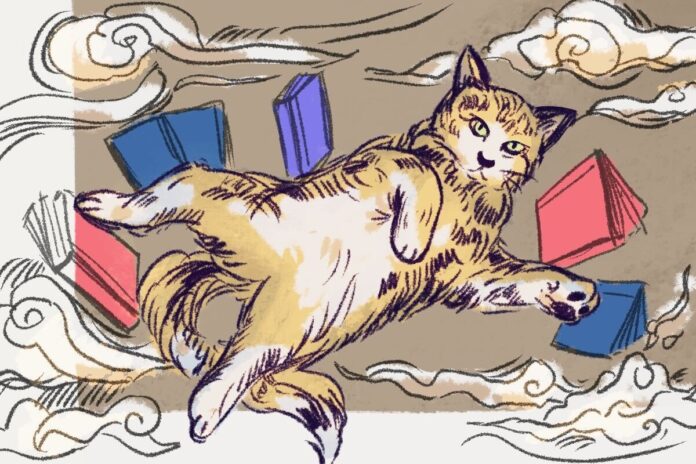
At face value, The Cat who Saved Books is a novella about passion for reading. The Japanese story vividly transports readers to a used bookstore and publishing house, with dusty hallways and crowded bookshelves. But beyond the surface, author Sôsuke Natsukawa presents a nuanced perspective on mourning.
The book narrates the life of Rintaro Natsuki, who inherits a second-hand bookshop after the death of his grandfather. When he is approached by a tabby cat named Tiger—who poses an outgoing foil to Rintaro’s bookish and withdrawn persona—a grieving Rintaro embarks on a quest through four labyrinths to save “books that have been imprisoned.”
School class representative Sayo Yuzuki joins Rintaro and Tiger on the way. They meet a cast of eccentric characters, all of whom claim to love books but all of whom show their love in ways Rintaro’s grandfather would have found dishonourable. One character hoards books with no intention of reading them, for example.
Throughout the journey, Rintaro learns to understand the different perspectives of the people he meets, and consequently changes their outlooks on life.
Western readers may associate the labyrinth with Greek mythology or with the trope of the labyrinth as a journey of self-discovery, according to translator Louise Heal Kawai. Likewise, the personified-animal-as-journey-guide archetype is reminiscent of modern stories such as the cats from Coraline and The Cat in the Hat, or Remy from Ratatouille.
At its core, the novella tells a story about grief. Rintaro’s perspective is heavily influenced by his grandfather and the bookshop he owned. As the inheritor of the bookshop, Rintaro revisits memories with his grandfather while discussing reading habits with people in the labyrinth. The characters Rintaro meets force him to grapple with the possibility that his grandfather was not always right.
The story shows a clear arch in Rintaro’s thoughts on his grandfather’s passing. The opening scene describes Rintaro closing his eyes at his grandfather’s funeral, signaling he may be in denial. However, three months later Rintaro is ready to accept his role as the new proprietor of Natsuki books and takes pride in the similarities he shares with his loved ones.
Despite this, Natsukawa’s narration leaves much to be desired. His writing style is simple to the point of feeling dumbed down, even for a younger audience. Pieces of dialogue are often sandwiched between long descriptions, making conversation hard to follow.
The romance between Rintaro and Sayo also feels cliché and unnecessary. Throughout the book, Sayo acts as a guide to bring her classmate back to his normal routine and help him work through his feelings. The romantic relationship that develops at the end of the story feels like an irrelevant, last-minute addition.
Overall, the story critically analyzes literary culture from a place of love, which is especially appealing to avid readers. Book lovers may relate to the perspectives of the characters from the labyrinth—this makes the dialogues between Rintaro more personal. Characters touch on issues readers may have discussed themselves, such as accumulating a large number of books without the intention of reading them.
Readers may also appreciate the references to Eastern and Western literature sprinkled through the novella, including references to plot points and themes that could only have been written by an avid reader.
Despite some unfortunate simplicity, readers can expect a unique story that builds on familiar works and offers a nuanced view of mourning. Through vivid scene descriptions, readers are magically transported into the dusty, cluttered bookshelves of Natsuki Books to follow along on Rintaro’s journey.
Featured graphic by Angel Xing.





